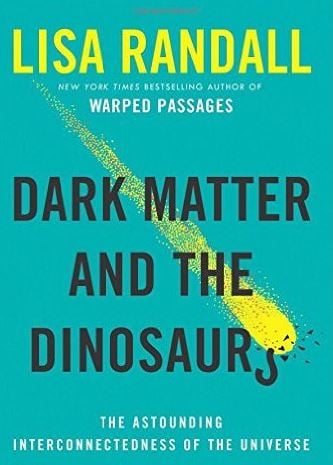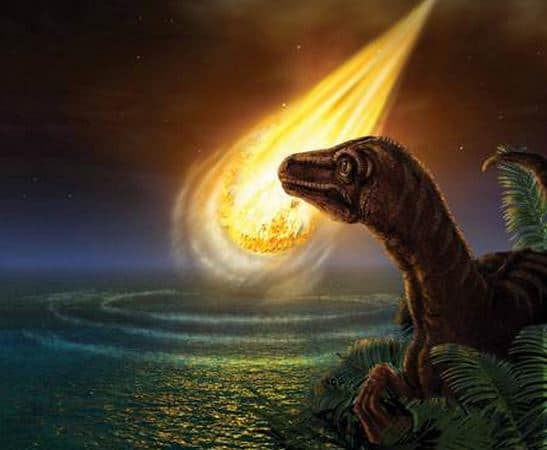What if dark matter is responsible for putting us – humans – here, and getting rid of the dinosaurs? Lisa Randall, a theoretical physicists explores this idea in her new book ‘Dark Matter and the Dinosaurs: The Astounding Interconnectedness of the Universe.’ She suggests that dark matter pushed the object that crashed into Earth and killed off the dinosaurs in our direction
Dark matter is invisible, enigmatic, and to most lay people – totally irrelevant to everyday life. Have you ever wondered, however, whether it could reach out and touch us? Probably not if you are not a physicist.
Lisa Randall, Frank B. Baird, Jr. Professor of Science at Harvard University’s Department of Physics, who specializes in theoretical particle physics and cosmology, is pondering the possibility that dark matter triggered the most famous cosmic collision that Earth ever experienced – one that did away with the dinosaurs and paved the way for mammals to grab their place.
 The first edition of Prof. Randall’s new book was published on October 27th, 2015. (Image: amazon.com)
The first edition of Prof. Randall’s new book was published on October 27th, 2015. (Image: amazon.com)
Dark matter’s link to distant comets
Prof. Randall sees interesting lines of evidence that link dark matter to comets in our Solar System’s distant Oort cloud, and from there to the impact crater on Mexico’s Yucatán coast caused by a collision 66 million years ago.
Prof. Randall, together with Matthew Reece, Assistant Professor of Physics at Harvard, explored the idea in an article published in 2014 in the journal Physical Review Letters.
Inspired by the intricate chain that appears to link dark matter, our Earth, dinosaurs, and modern life, Prof. Randall decided to take a leap into the subject in her new book.
Regarding how dark matter’s potential links drew her, Prof. Randall said:
“I was just fascinated by this story. It was really nice for me to be able to communicate about dark matter through its potential connections to what we see today.”
Her book, which came on the market on October 27th, 2015, takes us on a tour of the Universe, right from the beginning (Big Bang) to today, from the story of life to mass extinctions, from the very distant galactic disk to Earth’s K-T boundary layer – a thin blanket of dust that spans the globe, that scientists say is evidence of the catastrophic impact that brought about the extinction of the dinosaurs.
Prof. Randal suggests in her book that a thin disk of dark matter may have influenced weakly-bound comets on the edge of our Solar System as it revolved around the center of our galaxy (Milky Way), and may have been the ultimate cause of the cataclysmic collision.
 Professor Lisa Randall studies theoretical particle physics and cosmology at Harvard University. (Image: Harvard University)
Professor Lisa Randall studies theoretical particle physics and cosmology at Harvard University. (Image: Harvard University)
While admitting that the disk has not yet been found, she explains that current data allow for it, and that we are close to creating instruments that might detect it.
Prof. Randall’s book is full of analogies and anecdotes to explain some very complex scientific ideas.
We also learn something about Prof. Randall herself: She has a robot who vacuums her floors, likes to ski, and was once not taken for a cosmologist (one who studies the large scale properties of the universe as a whole), but a cosmetologist (a person who gives beauty treatments).
Was the collision caused by a comet or asteroid?
The dinosaurs’ extinction is a dramatic example of connectedness. Scientists are fairly sure the collision had devastating consequences, but there is some question as to whether it was from a rocky asteroid that originated within our Solar System or a comet from its outer edge, in a vast assemblage of icy bodies called the Oort cloud, which is about 100,000 AU from the sun. (1 AU = the distance from Earth to the Sun).
 Was the object that collided with Earth and brought about the dinosaurs’ demise pushed in our direction by dark matter?
Was the object that collided with Earth and brought about the dinosaurs’ demise pushed in our direction by dark matter?
If the dinosaur was eliminated by a comet, the next question is, what gave it that initial push in Earth’s direction? Scientists have an additional clue when confronting that question: the impact that killed the dinosaur was not the only one in Earth’s history.
Earth has experienced several collisions, and according to some evidence, they occur at regular intervals – galactically speaking – of between 30 and 35 million years.
The Oort cloud is so distant and the time scales involved so vast that researchers have sought answer outside the Solar System, which goes around the center of the Milky Way about every 240 million years, weaving its way up and down through the flattened plane of the galaxy as it travels.
Some scientists have explored whether that passage might perhaps bump a comet into a collision course with Earth. However, the band of visible matter in the galactic disk is diffuse enough that the collisions it might trigger do not match the timing of those on Earth.
 Although we cannot see dark matter or physically detect it, we know it is there because it has a gravitational pull that attracts visible matter and bends light. (Artist’s impression of dark matter)
Although we cannot see dark matter or physically detect it, we know it is there because it has a gravitational pull that attracts visible matter and bends light. (Artist’s impression of dark matter)
But, what about dark matter?
Although we cannot see dark matter, it is not entirely undetectable. Dark matter, like all matter, exerts a gravitational pull, and it is through dark matter’s gravitational effects on objects we can see in the Universe that scientists know it exists.
Dark matter, unlike visible matter, however, is not concentrated in the galactic disk. It is believed to be spread in a sphere around the galactic center that extends well beyond the concentration of stars and other visible matter.
Prof. Randall asks ‘What if there were more than one type of dark matter?’ There are several types of visible matter, aren’t there? And there is much more dark matter in the Universe than visible matter.
Scientists estimate that about 85% of all matter in the Universe is dark. So, why should it all be one type?
If there is a dark particle that can emit energy, as ordinary matter does, it would cool and condense, and would naturally form a rotating disk around the galactic center.
Dark-matter particles are hypothesized to be around 100 times larger than a proton, which means they would create a disk up to 100 times thinner and 20 times denser than the visible matter disk – thin enough to match the collision timing.
Prof. Randall said:
“Suppose dark matter had its own photon. It could radiate and form a disk and the consequences could be very interesting.”
Prof. Randall, whose previous work dealt with concepts such as extra dimensions and supersymmetry, said that apart from research, educating members of the public about science is a top priority.
Her three previous books were aimed at lay people. She once wrote a text for an opera based on her study of extra dimensions.
To Prof. Randal, the story of the impact that killed off the dinosaurs – one of five mass extinctions we know about – resonates today in chilling ways.
Prof. Randall said:
“It’s so important to understand history. There’s a sixth extinction going on. We’re losing so many species on this planet.”
Human activity is causing the sixth extinction. If the readers of Prof. Randall’s new book take away nothing else, she says she hopes they gain an understanding of just how interconnected the elements of the Universe can be, and how strongly we are linked to non-human life on Earth.
Video – Did dark matter kill off the dinosaurs?
